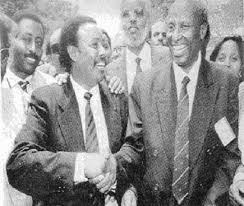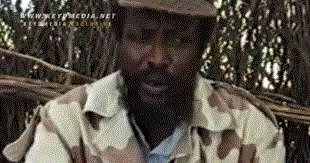By ismail H. Warsame
Somalia’s peaceful disintegration by remote control
On January 26, 1991, the central authority in Somalia finally lost its last stronghold, Mogadishu, and the collapse of the government became irreversible- a type of failed state that the world has not seen in recent memory emerged. Mogadishu fell into the hands of General Caydiid and hotelier Cali Mahdi as the leaders and militia commanders of exclusively Hawiye-dominated USC-Ethiopia and USC-Mogadishu/Rome. Like any other city-state of the so-called “Third World” countries, Mogadishu thus became the “real Somalia”, particularly for those foreigners involved in Somali issues.

It’s a custom for the diplomatic world to deal with only those who have control the Capital City. Somalia’s “International Partners” expressed awe and shock at the sad images and horrific exploits and the savagery of Caydiid and Cali Mahdi. World press branded them the “Most Powerful Warlords” in Somalia. They continued to dominate the headlines of the international press on Somalia for nearly a decade. The Hawiye clan came out to be perceived as the biggest, and therefore, the most powerful force to reckon with in Somalia’s clan-dominated politics.
Some non-Hawiye sub-clans in deep-South-Central Somalia joined the Caydiid-Cali Mahdi bandwagon as “second-rated” Hawiye clan members. Gosha or Jarer-Weyn or Bantu Somalis opted to call themselves “Kamasle Hawiye” (The big-nosed Hawiyes). Other Somali clans also aligned as minor stakeholders. With the connivance and blessings of Caydiid and Cali Mahdi, a tolerable leeway of acceptance, as secondary stake-holders, was accorded to the Issak sub-clans in the North-West as Hawiye’s incentive for “Anti-Darood alliance”. Although the Barre military regime’s brutality was indiscriminate toward all Somalis across clan lines, who dare to question his command; however, USC and SNM orchestrated a targeted communal violence of massive scale against the Daroods.
Consequently, General Caydiid could not maintain his political and military alliance with Col. Ahmed Omer Jees, an Ogaden, because of the policy of “Darood Clan Cleansing USC had put in place. Thus, General caydiid turned against his ally, Col Jees who was caught off-guard and without any warning.

The Marehans of post-Barre Somalia nearly lost self-confidence as part of Darood clan system, as the Hawiye came into prominence for the first time. The creation of Jubba Valley Alliance with Cayr, a sub-clan of Haber-Gedir was one of the symptoms of Marehan’s clan-politics schizophrenia in the illusion of new Somalia’s reality in Mogadishu.
As opportunistic and dishonest politicians deceived the people of North-West Regions of Somalia with their imagination of fantasy and fear-mongering of Southern domination, the people of the South-Central became equally misled into accepting an inferiority-complex scenario on the falsehoods of suffering from centuries of Majertinian rule. The biggest problem facing any Somali politician hailing from Hargeisa and Mogadishu now is how to un-program or undo the false and dangerous indoctrination of their clan powerbases, particularly the belief that Darood has been taking a lion’s share in Somalia’s clan-based government. Any rational and acceptable politician in Hargeisa and Mogadishu now fights against this “Been Fakatay (an accepted lie), as the Somalis say. In the case of Mogadishu, this historical falsehood are the main reasons for holding the entire country hostage and render it stateless for two decades, not understanding that by maintaining the status quo, Somalia, slowly, but surely, is disintegrating. Some in Hargeisa however, see such a scenario in Somalia as the best opportunity for Somaliland’s Campaign of Secession (Gooni-usu-Taag campaign).
As the dust of clan-cleansing finally settled in the North-West Regions (Somaliland), President Mohamed Ibrahim Egal, upon taking over the reins of power from Abdirahman Tuur, faced new challenges of local clan politics. The powerful Gar-Xajis alliance effectively hindered the leadership and mandate of his new administration in Hargeisa. President Egal took bold steps to bring them “down to their knees”, according to the contents of a personal letter he sent to his Haber-Awal business community in Djibouti at the time, to claim and boast off victory (I loaned the only copy of that letter to the Former Vice-President of Puntland State, Mohamed Abdi Hashi, and couldn’t get it back from him).
Amid the chaos and anarchy in South and South-Central Somalia, Somaliland unilaterally embraced secession in wishful thinking that it could survive alone after the disintegration of the Somali Republic. They even blatantly ignored the recent history of Hargeisa and Zeyla that almost got lost as part of the “Haud”, and once Somalia disappears, “Somaliland” will be the easiest land and sea-outlet assets to be claimed fast and swallowed irretrievably. Perhaps, some in Hargeisa want this to happen rather than to entertain themselves with the annoying music of Somali-weyn-and in this way, offer their children’s children the opportunity (or condemnation) to struggle for freedom once again. Tragically, Somaliland’s attempt to secede from Somalia stifles, if not eliminates its world-famous heritage of inventiveness in literature (hal-abuur suugaaneed). This can thrive again within the fold of Somalia with the freedom of people’s imagination in a wider competition and market for renaissance and renewal of arts and poetry among their brethren Somalis. Sadly, the current political atmosphere of Somaliland’s secession/independence (Gooni-usu-Taag) produces no more Hadraawis and Gaariyes. The opportunity for supply and demand is negligible there. It is ” one bedroom State”), as Somalis popularly describe Somaliland “Dawladda Qolka iyo barsadda.”
The Ogadens are torn apart between ONLF, Ethiopian occupation, and Kenyan political marginalisation, amid their disarray, following the disintegration of MOD (Marehan-Ogaden-Dhulbahante) Coalition Government, while the Majertaines are still recovering from Siyad Barre’s anti-revolutionary venture “Kacaan-diid” and “power-hungry bunch” profiling labels. Many suffer to-date from paranoia, as a result, regarding debate on leadership in any field of human endeavour, wherever they have to deal and interact with other Somali clan members, and habitually, they opt for low-profile and let go existence in Somalia and within the Diaspora. Fortunately, the Late President of Somalia, Abdullahi Yusuf, proves every one wrong and leads the way to rekindle their imagination on possibilities and potentialities. Hence, you see the Caddes’, Farooles’, and Abdiwelis’ types running for office.
In Somalia’s neighbourhood, Djibouti attempts to replace Somalia in international arena, keen to seize all it can to chew and swallow from the spoils of the Somali State, after suffering for a long time from the shadows of “Big Brother” Somalia (Siyad Barre’s towering image, in particular), and its junior membership of the Arab League. On the other hand, Ethiopia and Kenya see new opportunities for the scramble of the Somalia, and a good chance to deal with the “The problem Child of Africa,” effectively this time.
In the “Restore Hope”, President Bush’s campaign, the international community collectively tried to re-instate Somalia only once. They couldn’t. They, thus, finally decided to leave it to its own demise. They found out that every Somali is “his own Sultan” and cannot be re-civilized as “they are still tribal savages” as described by Richard Burton in his First Footsteps in East Africa over two hundred years ago.
The world community, however, faces a new problem: Somalia has become a danger not only to itself, but to international peace and security. The international community eventually decided to manage the country’s disintegration peacefully by containing its threat of terrorism within its borders. Powerful nations use proxy to remote control this troublesome and difficult people in the Horn of Africa. Today, I don’t think any keen observer of Somalia’s tragedy can fail to identify the elaborate levels and multitude of “security, developmental and humanitarian projects” put in place to ensure the country’s quiet disappearance from the geo-political map.
Ismail H. Warsame
WardheerNews contributor
Email:[email protected]
————–
Ismail H. Warsame is a founding member of Puntland Somali state and former chief of Staff, Puntland State first President 1998-2004.
We welcome the submission of all articles for possible publication on WardheerNews.com. WardheerNews will only consider articles sent exclusively. Please email your article today . Opinions expressed in this article are those of the author and do not necessarily reflect the views of WardheerNews.
WardheerNew’s tolerance platform is engaging with diversity of opinion, political ideology and self-expression. Tolerance is a necessary ingredient for creativity and civility.Tolerance fuels tenacity and audacity.
WardheerNews waxay tixgelin gaara siinaysaa maqaaladaha sida gaarka ah loogu soo diro ee aan lagu daabicin goobo kale. Maqaalkani wuxuu ka turjumayaa aragtida Qoraaga loomana fasiran karo tan WardheerNews.
Copyright © 2024 WardheerNews, All rights reserved


